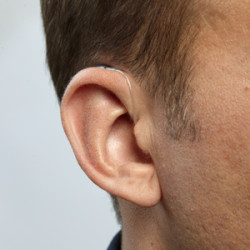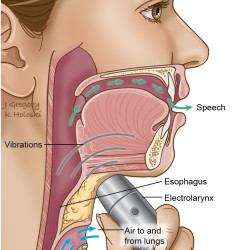While the sound processing involved in modern hearing aids is complex, and computer programming is required to make some of the adjustments, the basic components that make them work has not changed. The basic function of a hearing aid is as follows:
Sound waves enter through the microphone, which converts acoustic signals into electrical signals.
The amplifier increases the strength of the electrical signal.
From the amplifier, the signal is then transformed back to an acoustic signal by the receiver (a miniature loud speaker).
From the receiver the signal is channeled intro the ear canal, either through a small tube or through an ear mold.
A battery is required to power the hearing aid and enable the amplification process.
Many hearing aids also have user controls e.g. toggle switch, volume control wheel, push button, or remote control) that enable the wearer to adjust a variety of hearing aid parameters, including:
Turning the hearing aid “on” or “off”
Changing the volume
Switching to the telecoil
Switching between omni- and directional-microphone settings
Switching to a different pre-programmed memory

Pocket Model
• Basic hearing aid to meet the communication needs
• Easy to operate
• Cost effective
• Minimum maintenance

Behind The Ear (BTE)
• Cosmetically appealing
• Snugly fits at the ear level
• Easy to wear
• Customer’s first choice
• Available in two types – Computerised and Non-computerised

Mini BTE
Mini BTE with slim tube and tip
Mini BTEs are designed to hide behind the outer ear, and have ultra-thin tubing to discreetly route sound into the ear. The tubing connects to a soft tip that sits in the ear canal but doesn’t occlude it. The result is a natural, open feeling as airflow and sound enter the ear naturally around the tip, while amplified sound enters through the tip. This is known as “open fitting” and is recommended for mild to moderate high frequency losses.

Receiver in the ear (RITE)
Receiver in the ear (RITE)
RITE models, also known as RIC (receiver-in-canal) models, are mini BTEs that have the speaker of the instrument incorporated in the ear tip, instead of in the main body of the instrument. RITE instruments fit mild to severe hearing losses. This hearing aid style looks similar to the Mini BTE when worn on the ear.

Completely In the Canal (CIC)
• Dream hearing aid for persons with hearing impairment
• Virtually invisible hearing aid
• Suitable for mild to moderate hearing loss*

Invisible In the Canal (IIC)
The smallest custom style, IIC instruments site invisibly in or past the second bend of the ear canal. IIC are specifically designed for mild to moderate hearing loss.

Cochlear Implant
• Suitable for severe to profound hearing loss category (both the ears) and no significant benefit with hearing aid.
• Surgically implanted device
• One of the preferred solutions for complete deafness
• Requires team work of professionals and family members
• Long term process

Artificial Larynx
An electrolarynx, sometimes referred to as a “throat back”, is a medical device about the size of a small electric razor used to produce clearer speech by those people who have lost their voicebox, usually due to cancer of the larynx. The most common device is a handheld, battery-operated device placed under the mandible which produces vibrations and allow speech.[1] Earlier non-electric devices were called mechanical larynxes. Along with developing esophageal voice, robotic voice or undergoing a surgical procedure, the electrolarynx serves as a mode of speech recovery for laryngectomy patients.